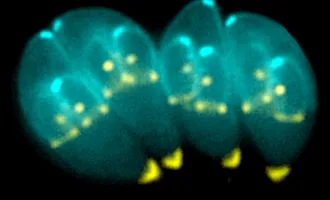Journal Club: Immunology, Genetics, and Neuroscience
IMMUNOLOGY: Cutting Edge: Memory regulatory T cells require IL-7 and not IL-2 for their maintenance in peripheral tissues. Gratz, I.K. et al. (Rosenblum). Journal of Immunology. March 29. [epub ahead of print]
When T-cells are first activated, they require the cytokine IL-2 in order to survive and proliferate; without IL-2, these cells lose the ability to replicate and they die. Regulatory T-cells (Tregs) are a unique type of T-cell that, when activated, promote tolerance to whatever they’re specific for, instead of initiating inflammation.
In this way, Tregs help to balance the immune response and prevent the effects of too much inflammation. Like other T-cells, Tregs require IL-2 for their initial activation and expansion. They also need continuing signals in order to stick around and become “memory” T-cells that can fight recurring infections quickly and efficiently even after the initial danger is gone.
In this paper, researchers found that memory Tregs require IL-7 instead of IL-2 for their long-term survival in the body, indicating a difference between initial stimulation and long-term persistence.
GENETICS: The role of ATM in the deficiency in nonhomologous end-joining near telomeres in a human cancer cell line. Muraki, K.; Han, L.; Miller, D.; Murnane, J.P. PLoS Genetics. 9(3):e1003386.
Telomeres have a number of essential functions, only one of which is to protect the ends of chromosomes from degradation upon cell replication. Another essential role of telomeres is to mark the end of a chromosome, so that repair mechanisms don’t accidentally consider chromosome ends to be a “double-stranded break,” or DSB.
In this sense, telomeres protect chromosomes from being accidentally attached together into one long piece of DNA instead of 23 pairs of chromosomes. However, the cell gets into trouble if the telomere actually does have a DSB, because it is often repaired incorrectly.
Normal repair of DSBs involves the kinase ATM; here, researchers wanted to determine whether the problem with telomere-proximal DSBs involves defective DSB repair or accidental treatment of the DSB, as if it is a normal chromosomal end. They found that ATM was not involved in defective telomeric DSB repair and therefore concluded that the cellular deficiency was caused by treatment of the DSB as a chromosomal end and not defective DSB repair.
IMMUNOLOGY: T-cells target APOBEC3 proteins in HIV-1-infected humans and SIV-infected Indian Rhesus macaques. Champiat, S. et al. (Nixon). Journal of Virology. March 27. [epub ahead of print]
APOBEC3 is a protein expressed by B-cells to mutate antibody genes so that they can better bind to unexpected things we might get exposed to. APOBEC3 also helps to fight HIV infection by hypermutating viral DNA and making it less likely that the virus can productively replicate in a cell.
To counteract this, HIV has the protein Vif, which targets APOBEC3 for degradation. Once degraded by the cell, it gets placed, like an advertisement, on the billboard-like molecule MHCI, which broadcasts what types of proteins have recently been degraded.
In this paper, researchers found that there are T-cells specific for cells that have placed APOBEC3 on MHCI, which, they hypothesize, represents a way to fight HIV infection despite inactivation of APOBEC3. According to their model, the T-cells will presumably kill the cells with APOBEC3 on MHCI that have likely also been infected with HIV.
NEUROSCIENCE: Cellular source-specific effects of apolipoprotein (apo) e4 on dendrite arborization and dendritic spine development. Jain, S., Yoon, S.Y., Leung, L., Knoferle, J., Huang, Y. PLoS One. 8(3):e59478.
ApoE4 is a version of Apolipoprotein (apo) that is found in roughly 14 percent of the population and is a risk factor for Alzheimer’s disease. Apo is expressed in large part by astrocytes, although neurons also express it in times of stress. It is thought to contribute to the development of Alzheimer’s, due to potential interaction with amyloid, but much remains unknown.
In this paper, researchers wanted to determine the effects of neuronal ApoE4 on two aspects of neuronal function: dendrite arborization (how many dendrites the neuron can make) and dendritic spine development (little spikes on the dendrites that further increase the cell’s ability to communicate with other cells). They found that ApoE4 caused defects in both dendritic arborization and dendritic spine development, and that these defects were worse when the ApoE4 was expressed by neurons, not astrocytes.


